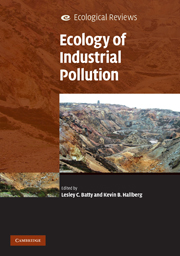Book contents
- Frontmatter
- Contents
- List of contributors
- Preface
- Acknowledgements
- 1 Consequences of living in an industrial world
- 2 Metallophytes: the unique biological resource, its ecology and conservational status in Europe, central Africa and Latin America
- 3 Lichens and industrial pollution
- 4 The impacts of metalliferous drainage on aquatic communities in streams and rivers
- 5 Impacts of emerging contaminants on the environment
- 6 Ecological monitoring and assessment of pollution in rivers
- 7 Detecting ecological effects of pollutants in the aquatic environment
- 8 With the benefit of hindsight: the utility of palaeoecology in wetland condition assessment and identification of restoration targets
- 9 An ecological risk assessment framework for assessing risks from contaminated land in England and Wales
- 10 Diversity and evolution of micro-organisms and pathways for the degradation of environmental contaminants: a case study with the s-triazine herbicides
- 11 The microbial ecology of land and water contaminated with radioactive waste: towards the development of bioremediation options for the nuclear industry
- 12 The microbial ecology of remediating industrially contaminated land: sorting out the bugs in the system
- 13 Ecological recovery in a river polluted to its sources: the River Tame in the English Midlands
- 14 Manchester Ship Canal and Salford Quays: industrial legacy and ecological restoration
- 15 Large-scale mine site restoration of Australian eucalypt forests after bauxite mining: soil management and ecosystem development
- 16 Sustaining industrial activity and ecological quality: the potential role of an ecosystem services approach
- Index
- Plate section
- References
16 - Sustaining industrial activity and ecological quality: the potential role of an ecosystem services approach
Published online by Cambridge University Press: 05 June 2012
- Frontmatter
- Contents
- List of contributors
- Preface
- Acknowledgements
- 1 Consequences of living in an industrial world
- 2 Metallophytes: the unique biological resource, its ecology and conservational status in Europe, central Africa and Latin America
- 3 Lichens and industrial pollution
- 4 The impacts of metalliferous drainage on aquatic communities in streams and rivers
- 5 Impacts of emerging contaminants on the environment
- 6 Ecological monitoring and assessment of pollution in rivers
- 7 Detecting ecological effects of pollutants in the aquatic environment
- 8 With the benefit of hindsight: the utility of palaeoecology in wetland condition assessment and identification of restoration targets
- 9 An ecological risk assessment framework for assessing risks from contaminated land in England and Wales
- 10 Diversity and evolution of micro-organisms and pathways for the degradation of environmental contaminants: a case study with the s-triazine herbicides
- 11 The microbial ecology of land and water contaminated with radioactive waste: towards the development of bioremediation options for the nuclear industry
- 12 The microbial ecology of remediating industrially contaminated land: sorting out the bugs in the system
- 13 Ecological recovery in a river polluted to its sources: the River Tame in the English Midlands
- 14 Manchester Ship Canal and Salford Quays: industrial legacy and ecological restoration
- 15 Large-scale mine site restoration of Australian eucalypt forests after bauxite mining: soil management and ecosystem development
- 16 Sustaining industrial activity and ecological quality: the potential role of an ecosystem services approach
- Index
- Plate section
- References
Summary
Introduction
Modern societies benefit greatly from the products of industry and ecosystems provide the raw materials and energy required to produce them. Societies also benefit from a wide range of other ecosystem services including the supply of food, fuel, fibre and water, the regulation of disease and climate, recreational opportunities and aesthetic enjoyment. However, there is a potential conflict between these two types of benefits as increased industrialisation is often associated with increased release of hazardous chemicals or habitat modification, which have the potential to degrade ecosystem services, including those required for continued industrial production and development.
Here we consider the relationship between industrialisation and environmental impact using the development of Sheffield's metal industries as a case study. We then go on to explore the broader question of ecological quality and how it is defined, before outlining a quality assessment framework based on ecosystem services that may provide a tool for managing ecosystems for the optimal delivery of services. Finally, we consider the global aspects of economic development, industrialisation and environmental degradation.
Environmental impacts of industry: Sheffield metal industries and the River Don
Sheffield is synonymous with steel and metal has been worked here since at least the Middle Ages. Early metal workers capitalised on the environmental resources provided by the region: fast flowing rivers for water power, oak woodlands for charcoal, iron ore for smelting and grit stone for grinding. Later the locally abundant coal became an important source of power.
- Type
- Chapter
- Information
- Ecology of Industrial Pollution , pp. 327 - 344Publisher: Cambridge University PressPrint publication year: 2010
References
- 2
- Cited by

